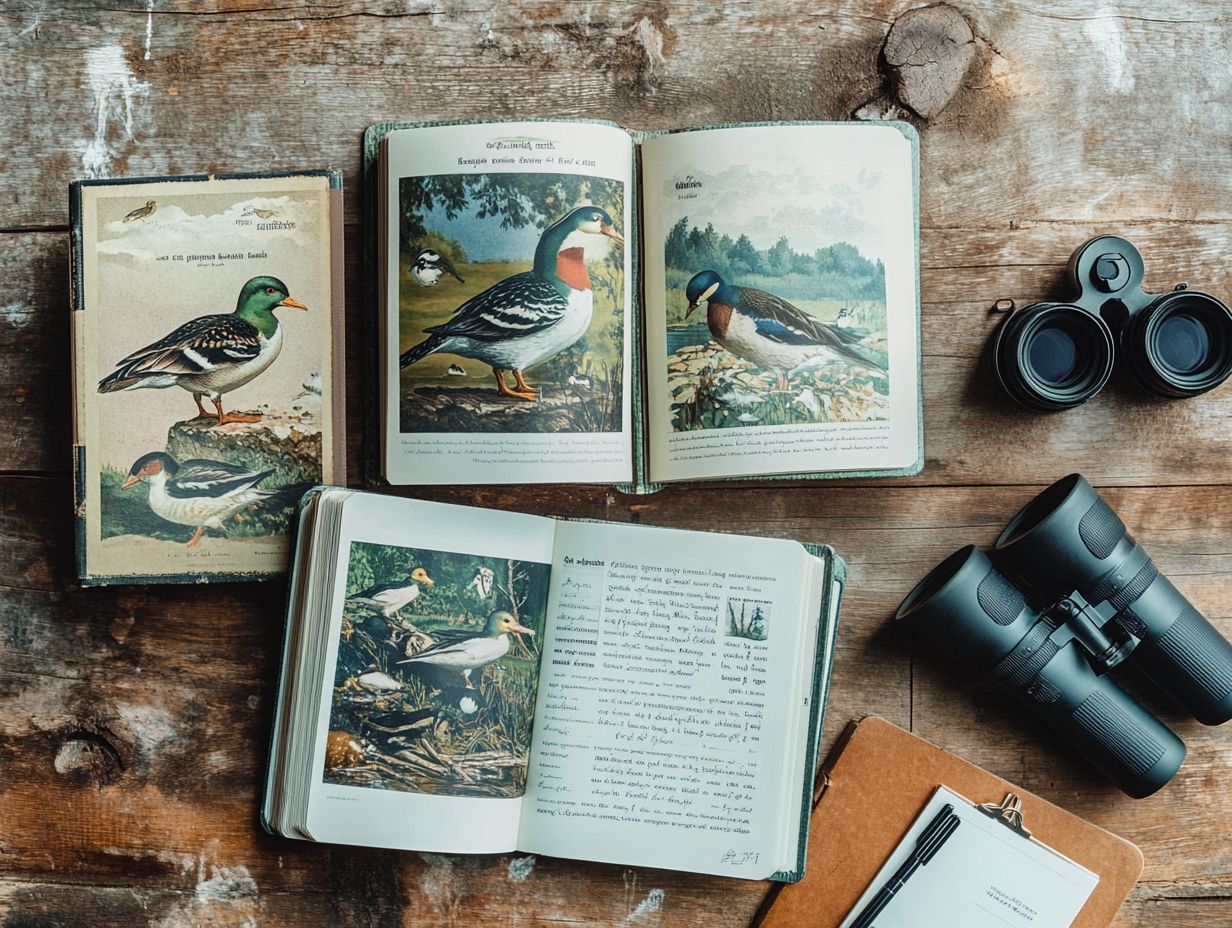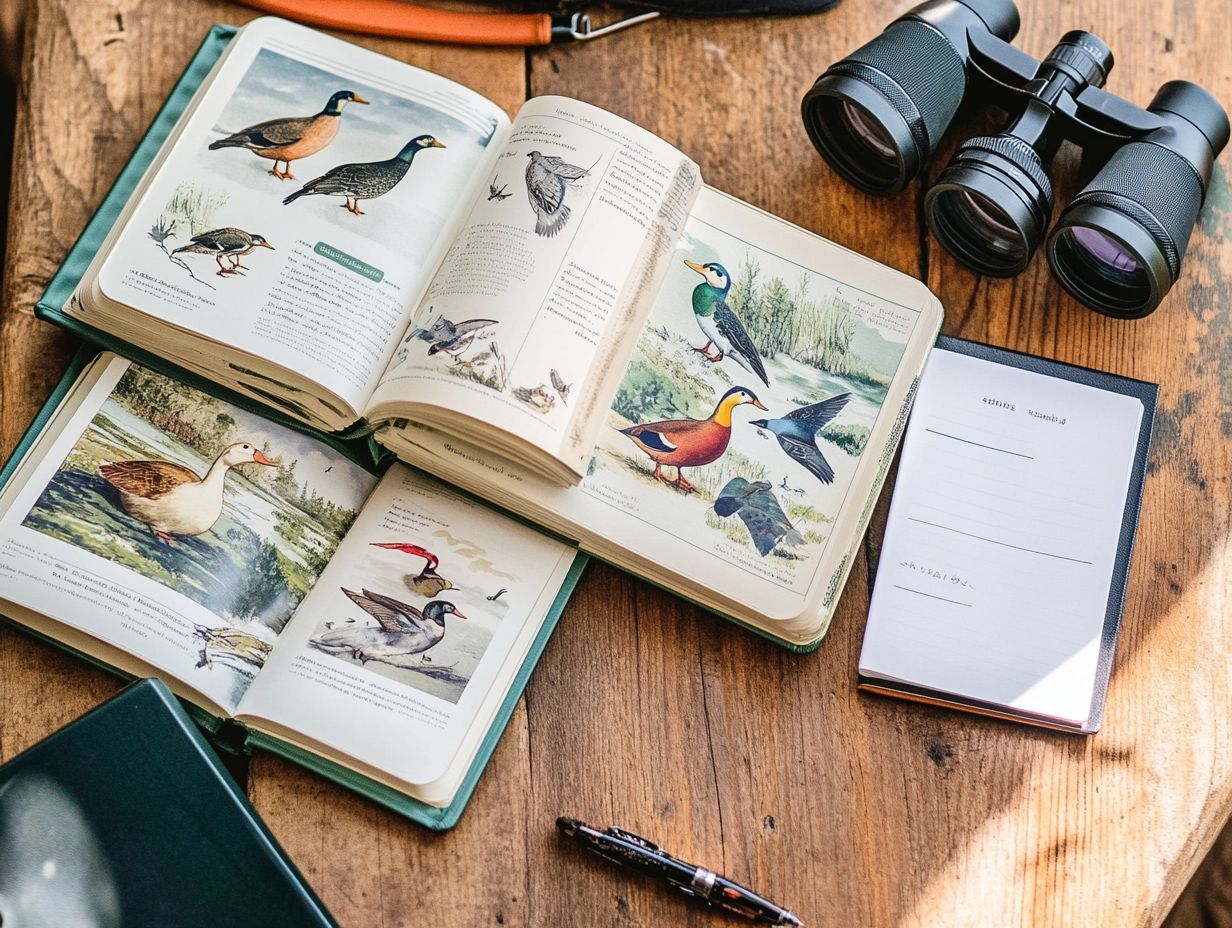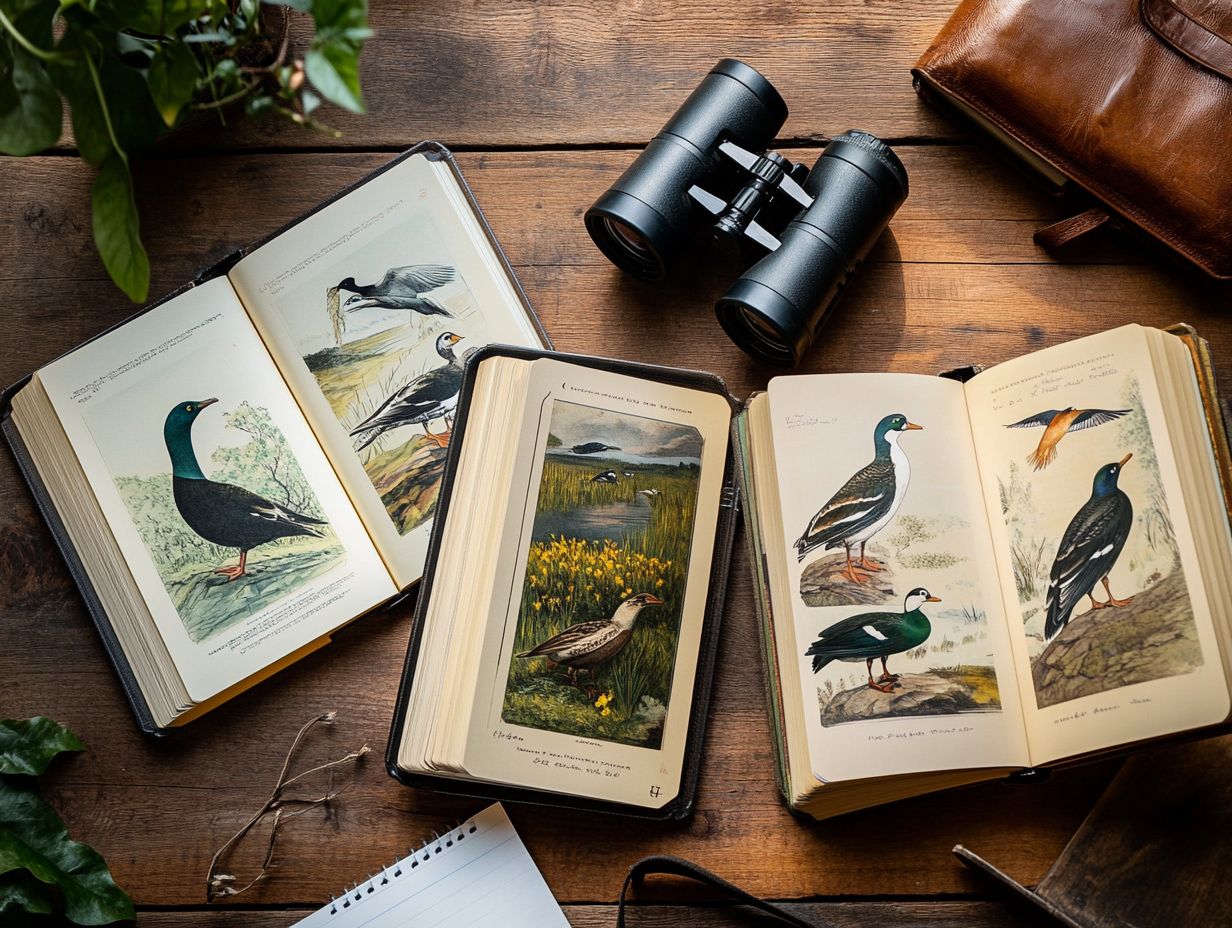Top 5 Field Guides for Waterfowl Identification
Are you passionate about birdwatching or hunting? This article explores the top five field guides essential for recognizing North America’s diverse waterfowl species.
With comprehensive illustrations and expert insights, these guides provide invaluable resources for both identification and conservation efforts. You will also find tips on how to utilize these guides effectively, along with common pitfalls to sidestep. This ensures your outdoor adventures are as rewarding as they are enlightening.
Dive into the thrilling adventure of discovering waterfowl!
Contents
- Key Takeaways:
- 1. The Sibley Guide to Birds
- 2. National Geographic Field Guide to the Birds of North America
- 3. Peterson Field Guide to Birds of North America
- 4. Ducks, Geese, and Swans of North America
- 5. The Waterfowl Hunter’s Guide
- What Are the Key Features to Look for in a Waterfowl Field Guide?
- What Are the Benefits of Using a Field Guide for Waterfowl Identification?
- How Can a Field Guide Help with Conservation Efforts for Waterfowl?
- What Are the Different Types of Waterfowl Covered in These Guides?
- What Are Some Tips for Using a Field Guide to Identify Waterfowl?
- What Are Some Common Mistakes to Avoid When Using a Field Guide for Waterfowl Identification?
- Frequently Asked Questions
Key Takeaways:

- The right field guide can greatly enhance your waterfowl identification skills and help with conservation efforts of bird species.
- Look for guides that cover a wide range of waterfowl, have detailed illustrations, and provide useful tips for identification.
- When using a field guide, pay attention to key features such as size, shape, color, and behavior to accurately identify waterfowl species.
1. The Sibley Guide to Birds
The Sibley Guide to Birds is your go-to resource for birdwatching in North America, seamlessly blending detailed illustrations and photographs to help you accurately identify birds across various subspecies and habitats. This field guide, along with others such as the Kaufman Field Guide and Audubon Bird Guide, excels in showcasing the rich avian diversity of the region. It is an essential companion whether you re a budding birder or a seasoned ornithologist, exploring the lush forests of East Texas or the scenic coastal areas of California.
Its unique illustrations capture the subtle nuances in plumage and shape that set similar species apart, allowing you to make quick and reliable identifications on the fly. Covering a wide range of habitats from wetlands to mountainous terrains it ensures you have a comprehensive understanding of North America’s diverse bird populations.
When compared to other field guides, you’ll find it boasts an impressive array of photographs that enhance your learning and recognition, simplifying the often intricate task of bird identification. This harmonious blend of artistic detail and practical information creates a user-friendly experience, making it the preferred choice for many birding enthusiasts like yourself.
2. National Geographic Field Guide to the Birds of North America
The National Geographic Field Guide to the Birds of North America is an exceptional resource for birdwatching enthusiasts like you. It offers a thorough exploration of various species and their unique field marks, which are the distinctive features that help identify different bird species.
This guide organizes information meticulously, presenting detailed descriptions that encompass habitat preferences, behaviors, and vocalizations, ensuring you whether a beginner or a seasoned birdwatcher can navigate it with ease. Stunning photographs capture the essence of each species, allowing you to draw direct comparisons with the live birds you encounter in the field.
The inclusion of range maps provides invaluable insights into migration patterns and seasonal presence, enabling you to track your sightings more efficiently. By harmonizing a user-friendly layout with substantial content, this guide acts as both a reference and an educational tool, enriching your birdwatching experience, no matter your level of expertise.
3. Peterson Field Guide to Birds of North America
The Peterson Field Guide to Birds of North America is a cornerstone reference that has transformed the way you and countless bird enthusiasts approach birdwatching. Its pioneering identification techniques and captivating illustrations serve as your roadmap for effective subspecies identification.
Originally hitting the shelves in the mid-20th century, this guide introduced a systematic approach that highlights the importance of observing specific field marks and colors. This enables you to identify species with greater accuracy, regardless of your experience level.
The choice of detailed illustrations over photographs offers a refreshing perspective, making the guide versatile for various lighting conditions and viewing angles.
This innovative approach deepens your connection with the avian world and inspires a generation of naturalists perhaps even you to document their findings with newfound precision. The impact on the birdwatching community is profound, echoing through the years and shaping how enthusiasts engage with nature today.
4. Ducks, Geese, and Swans of North America

“Ducks, Geese, and Swans of North America” is your ultimate field guide, dedicated to helping you identify and understand these captivating waterfowl. It offers crucial insights into their behaviors, habitats, and unique distinguishing features.
With a diverse array of species thriving in environments ranging from tranquil lakes to vibrant wetlands, this guide is designed to elevate your birdwatching experience. You ll find practical tips for identifying these avian wonders by observing their plumage patterns, vocalizations, and flight styles.
Gaining a deeper understanding of the ecology of these magnificent birds helps you appreciate more while highlighting the essential conservation efforts needed to protect their habitats.
Learn the specific characteristics of each species, and actively contribute to the ongoing study and preservation of North America’s rich waterfowl populations.
5. The Waterfowl Hunter’s Guide
The Waterfowl Hunter’s Guide is your essential companion, crafted for both avid hunters and birdwatchers. It offers a comprehensive look at the techniques and strategies that lead to successful waterfowl identification and hunting across various regions of North America.
This guide will sharpen your skills and excitement for the hunt! It underscores the moral responsibilities that accompany this cherished sport. Understanding the intricate details of different waterfowl subspecies, from their unique markings to their preferred habitats, is vital for any conscientious enthusiast.
This knowledge enables you to make informed decisions, helping you distinguish between species and pursue your quarry ethically. A deeper understanding of these nuances will boost your success in the field and contribute to vital conservation efforts for waterfowl species, promoting a sustainable balance between human activities and wildlife preservation.
What Are the Key Features to Look for in a Waterfowl Field Guide?
When you’re selecting a waterfowl field guide, consider several key features that enhance usability. Look for accurate illustrations, high-quality photographs, and detailed descriptions of various subspecies to improve your identification skills in the field.
These elements are crucial for helping you differentiating between species, particularly when ducks and geese appear strikingly similar. Bright, eye-catching illustrations can showcase subtle differences in feather colors and designs that are vital for proper identification.
Clear descriptions and specific field marks, such as bill shape or wing patterns, allow you to quickly recognize and appreciate distinctions, even from a distance.
Guides that include seasonal variations in appearance can be incredibly beneficial, aiding you in pinpointing the exact species you encounter throughout the year.
What Are the Benefits of Using a Field Guide for Waterfowl Identification?
Using a field guide for waterfowl identification brings a wealth of benefits your way. It enhances your birdwatching experiences with improved accuracy and boosts your confidence in identifying various species. Additionally, it provides access to captivating illustrations that beautifully depict these birds.
These guides also serve as invaluable educational resources, helping you develop a deeper understanding of local ecosystems and the essential roles waterfowl play within them. By utilizing such a tool, you can sharpen your observation skills and learn to notice the subtle differences in the feathers of a bird, behavior, and habitat preferences. This attention to detail not only enriches your personal experiences but also deepens your appreciation for the variety of life.
As you engage more with your surroundings, you play an important role in conservation efforts, ensuring that future generations can revel in the splendor of these elegant creatures!
How Can a Field Guide Help with Conservation Efforts for Waterfowl?

A well-structured field guide is essential in your conservation efforts for waterfowl. It enables you to accurately identify species, fosters awareness of their habitats, and encourages responsible birdwatching practices that contribute to the protection of these magnificent creatures.
With engaging illustrations and detailed descriptions, these guides elevate your birdwatching experience while serving as invaluable educational resources. As you explore the lives and environments of various waterfowl, you ll likely cultivate a deeper appreciation for the intricate ecosystems that sustain them. This newfound knowledge can spark a passion for environmental stewardship, inspiring you to advocate for policies that support wetland conservation.
By nurturing a community of informed birdwatchers, these field guides facilitate collective action aimed at preserving vital habitats crucial for migratory birds. In doing so, they help ensure these amazing birds thrive for our children and beyond!
What Are the Different Types of Waterfowl Covered in These Guides?
Field guides provide a deep dive into the world of waterfowl. You’ll discover ducks, geese, and swans, each with unique traits and habitat preferences. For those interested in enhancing their knowledge, knowing what the best field guides for birding are is critical for anyone eager to refine their bird identification skills.
As you explore the various species and subspecies outlined in these guides, you ll not only notice the visual distinctions but also gain insight into the vital ecological roles each bird plays within its environment. Understanding how these waterfowl interact with their ecosystems through their feeding habits, migratory patterns, and nesting behaviors will undoubtedly enrich your birdwatching experience.
For example, observing how certain species contribute to the health of wetlands or act as indicators of environmental change can significantly deepen your connection to nature and highlight the critical importance of conservation efforts.
What Are Some Tips for Using a Field Guide to Identify Waterfowl?
Focus on these key strategies to maximize your field guide experience. Pay close attention to field marks, understand the habitat preferences of various species, and don t underestimate the power of both illustrations and photographs for precise identification.
Taking a moment to observe the birds’ behaviors can reveal invaluable clues about their species. For instance, how a bird swims or interacts with its surroundings can help you distinguish between similar-looking ducks or geese.
When you re out in the field, practice comparing features like bill shape or color variations details that are easily noted in your field guide. Keeping a notebook handy to jot down observations, such as the time of day or specific locations, will deepen your understanding of local waterfowl populations and their lifecycles.
What Are Some Common Mistakes to Avoid When Using a Field Guide for Waterfowl Identification?
New birdwatchers often stumble into common pitfalls when using a field guide for waterfowl identification. They might overlook critical field marks, misidentify similar species, or fail to account for geographical variations and subspecies.
It s easy to rush through the identification process. Remember, patience and attention to detail are essential. Developing keen observational skills will elevate your birdwatching experience. For example, examining subtle differences in plumage or behavior can reveal a wealth of information.
Learn about the birds’ preferred habitats and seasonal patterns to improve your identification skills. Consulting experienced birders or joining local birdwatching groups can provide valuable tips. Taking careful notes during your observations will help you retain crucial information, ultimately deepening your knowledge and appreciation of these magnificent creatures in their natural environments.
Frequently Asked Questions

What are the top 5 field guides for waterfowl identification?
- “Sibley’s Waterfowl of North America” by David Allen Sibley
- “The Crossley ID Guide: Waterfowl” by Richard Crossley
- “National Geographic Field Guide to Birds: North America” by Jonathan Alderfer
- “Ducks, Geese, and Swans of North America” by Guy Baldassarre
- “Waterfowl of North America, Europe, and Asia: An Identification Guide” by Sebastien Reeber.
What makes these field guides stand out for waterfowl identification?
These field guides are top choices for waterfowl identification because they contain complete and accurate information on various waterfowl species, including their behaviors, habitats, and distinct physical features. For those looking to enhance their birding experience, consider exploring the top field guides for coastal birding adventures, which also include detailed illustrations and photographs to aid in identification.
Do these field guides cover all waterfowl species?
While these field guides cover a wide range of waterfowl species, it is important to note that there are over 150 species of ducks, geese, and swans worldwide. Some of the rarer or more regional species may not be included in these guides.
Can these field guides be used for both beginners and experienced birders?
Yes, these field guides are suitable for both beginners and experienced birders. They provide detailed information and illustrations for each species, making them useful for those just starting to learn about waterfowl as well as for those looking to expand their knowledge.
Are there digital versions available for these field guides?
Yes, all of these field guides are available in digital versions, such as e-books or mobile apps. This can be a convenient and portable option for birders in the field.
Can these field guides be used for other types of bird identification?
While these field guides are specifically geared towards waterfowl identification, they may also include information and illustrations for other types of birds commonly found near water. However, for more comprehensive guides on all bird species, it is recommended to refer to a general bird field guide.
Explore these guides to enhance your birdwatching journey and share your experiences with fellow enthusiasts!






